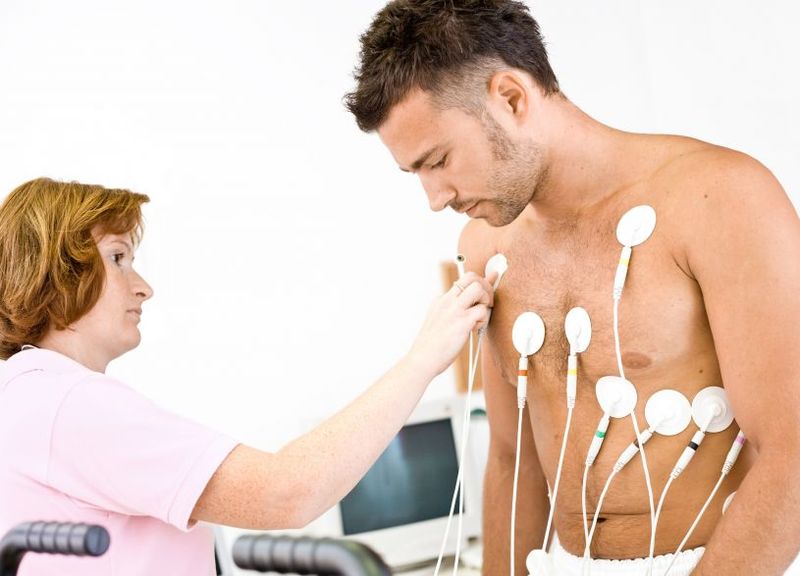Electrocardiograph
How the test is performed
You will be asked to lie down. The doctor will clean several areas on the arms, legs and chest and then fix small patches called electrodes on them. It may be necessary to shave or grab some hair so that the electrodes stick to the skin. The number of patches used may vary.
The patches are connected by cables to a machine that transforms the electrical signals coming from the heart into wavy lines, which are printed on paper. The doctor reviews the test results.
You will need to remain still during the procedure. Also, the doctor may ask you to hold your breath for a few seconds as the test is being done.
It is important to be relaxed and warm during an ECG record, because any movement, even shivering, can alter the results.
Sometimes, this test is done while you are exercising or are under slight stress to look for changes in the heart. This type of ECG is often called a stress test.

Exam Preparation
Make sure the doctor knows about all the medications you are taking. Some medications may interfere with the test results.
Do not exercise or drink cold water immediately before an ECG because these actions can cause false results.
What it feels like during the exam
An electrocardiogram is painless. No electricity is sent through the body. Electrodes may feel cold when first applied. In rare cases, some people may develop a rash or irritation where the patches were placed.
Reasons why the test is performed
An ECG is used to measure:
- Any damage to the heart.
- How fast the heart is beating and if it is doing it normally.
- The effects of drugs or devices used to control the heart (such as a pacemaker).
- The size and position of the heart chambers.
An ECG is often the first test done to determine if a person has heart disease. The doctor can order it if:
- You have chest pain or palpitations.
- It is scheduled for surgery.
- He has had heart problems in the past.
- He has a strong history of heart disease in the family.
There is no reason for healthy people to have electrocardiograms annually.
Normal results
Normal test results include:
- Heart rate: 60 to 100 beats per minute.
- Heart rate: constant and uniform.
Meaning of the abnormal results
Abnormal ECG results may be a sign of:
- Damage or changes in the myocardium.
- Changes in the amount of electrolytes (such as potassium and calcium) in the blood.
- Congenital heart abnormality.
- Enlargement of the heart
- Liquid or swelling in the sac around the heart.
- Inflammation of the heart (myocarditis).
- A past or present heart attack.
- Insufficient blood flow to the arteries of the heart.
- Abnormal heart rhythms (arrhythmias)
Some heart problems that can lead to changes in an ECG include:
- Flutter / atrial fibrillation.
- Heart failure.
- Multifocal atrial tachycardia.
- Paroxysmal supraventricular tachycardia.
- Sick Sinus Syndrome
- Wolff-Parkinson-White syndrome
Risks
There are no risks.
Considerations
The accuracy of the electrocardiogram depends on the condition being evaluated. A heart problem may not appear on the ECG. Some heart conditions never produce any specific change in it.
Address:
Street Margaritas #49, Sm.22, M.25, Cancun, Quintana Roo, Mexico.
Working hours:
Monday to Friday from 9:30am to 2:00pm and 4:30pm to 9:00pm
Phones:
- 998) 884-02-86
- (998) 884-12-29
Follow us:
Email:
medicinadeportiva@live.com
